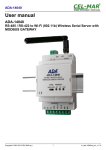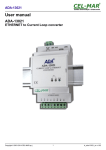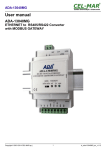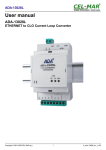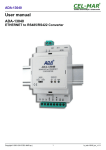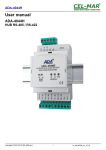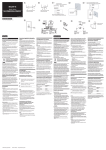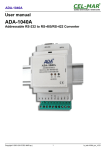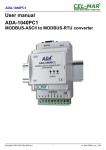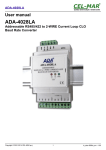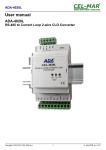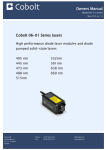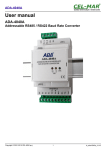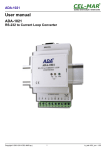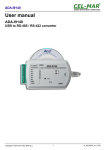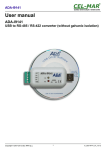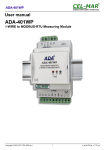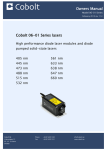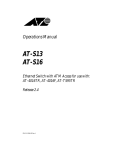Download User manual ADA-14110 RS232 to Wi-Fi (802.11b - CEL-MAR
Transcript
ADA-14110 User manual ADA-14110 RS232 to Wi-Fi (802.11b) Wireless Serial Server with MODBUS GATEWAY Copyright © 2001-2014 CEL-MAR sp.j. 1 io_ada-14110_en v1.11 ADA-14110 Contents 1. GENERAL INFORMATION...................................................................................................................................................................... 4 1.1. WARRANTED INFORMATION ...................................................................................................................................................... 4 1.2. GENERAL CONDITIONS FOR SAFE USE.................................................................................................................................... 4 1.3. CE LABEL....................................................................................................................................................................................... 4 1.4. ENVIRONMENTAL PRESERVATION............................................................................................................................................. 4 1.5. SERVICE AND MAINTENANCE..................................................................................................................................................... 4 2. PRODUCT INFORMATION..................................................................................................................................................................... 4 2.1. PROPERTIES................................................................................................................................................................................. 4 2.2. DESCRIPTION................................................................................................................................................................................ 5 2.3. WIRELESS NETWORK COMMUNICATIONS (WLAN)..................................................................................................................6 2.3.1. COMMUNICATIONS IN THE TCP/UDP SOCKETS MODE...................................................................................................6 2.3.2. COMMUNICATIONS IN THE VIRTUAL SERIAL PORT MODE (RealPort)............................................................................6 2.3.3. COMMUNICATIONS IN THE SERIAL BRIDGE MODE ........................................................................................................6 2.3.4. COMMUNICATIONS IN THE INDUSTRIAL AUTOMATION MODE (Modbus Gateway)........................................................6 2.3.5. OTHER COMMUNICATION TYPES....................................................................................................................................... 6 2.4. ISOLATION..................................................................................................................................................................................... 6 3. INSTALLATION........................................................................................................................................................................................ 6 3.1. ASSEMBLING................................................................................................................................................................................. 7 3.2. CONNECTION TO WI-FI WIRELESS NETWORK (WLAN)...........................................................................................................7 3.2.1. CONNECTION OF THE WIRELESS SERIAL SERVER TO COMPUTER BY THE USE OF WIRELESS NETWORK ADAPTER......................................................................................................................................................................................... 7 3.2.2. CONNECTION TO COMPUTER VIA NETWORK DEVICES ACCESS-POINT TYPE, ROUTER WI-FI................................7 3.2.3. CONNECTION TO COMPUTER VIA INTERNET BY THE USE ROUTER WI-FI / DSL........................................................8 3.2.4. CONNECTION FOR FUNCTIONING IN MODE TCP/UDP SERIAL BRIDGE ......................................................................9 3.2.5. CONNECTION OF THE WIRELESS SERIAL SERVER TO FUNCTIONING IN MODBUS GATEWAY MODE...................10 3.3. CONNECTING OF RS232 INTERFACE DEVICES...................................................................................................................... 11 3.3.1. CONNECTING OF DEVICE WITH RS232 POR, DTE TYPE (PC COMPUTER).................................................................11 3.3.2. CONNECTING OF DEVICE WITH RS232 POR,T DCE TYPE (MODEM, CODE READER)...............................................11 3.4. CONNECTING POWER SUPPLY................................................................................................................................................. 11 4. STARTUP............................................................................................................................................................................................... 12 5. CONFIGURATION................................................................................................................................................................................. 12 5.1. INITIAL CONFIGURATION USING ADAFINDER SOFTWARE....................................................................................................12 5.1.1. ADAFINDER INSTALLATION............................................................................................................................................... 12 5.1.2. NETWORK SETTING.......................................................................................................................................................... 12 5.2. CONFIGURATION AND MANAGEMENT BY THE USE OF INTERNET BROWSER...................................................................14 5.2.1. NETWORK CONFIGURATION............................................................................................................................................ 14 5.2.1.1. IP ADDRESS CONFIGURATION ............................................................................................................................... 14 5.2.1.2. WLAN CONFIGURATION........................................................................................................................................... 15 5.2.1.3. WLAN SECURITY SETTINGS.................................................................................................................................... 15 5.2.1.4. CONFIGURATION SETTINGS FOR WLAN NETWORK ACCESS AUTHORIZATION...............................................16 5.2.1.5. NETWORK SERVICES SETTINGS............................................................................................................................ 16 5.2.1.6. IP FORWARDING SETTINGS..................................................................................................................................... 16 5.2.1.7. SOCKET TUNNEL SETTINGS.................................................................................................................................... 16 5.2.1.8. ADVANCED NETWORK SETTINGS........................................................................................................................... 16 5.2.2. SERIAL PORT CONFIGURATION....................................................................................................................................... 16 5.2.2.1. PORT PROFILES (OPERATING MODES).................................................................................................................. 16 5.2.2.1.1. REALPORT (VIRTUAL PORT ) CONFIGURATION............................................................................................17 5.2.2.1.2. TCP SOCKETS CONFIGURATION.................................................................................................................... 17 5.2.2.1.2.1. TCP SERVER AND CLIENT CONFIGURATION........................................................................................18 5.2.2.1.2.2. THE 'ENABLE TCP KEEP-ALIVE' OPTION CONFIGURATION................................................................19 5.2.2.1.2.3. SERIAL PORT TRANSMISSION PARAMETERS CONFIGURATION........................................................19 5.2.2.1.3. UDP SOCKETS CONFIGURATION.................................................................................................................... 19 5.2.2.1.3.1. UDP CLIENT & SERVER CONFIGURATION IN CASE OF MASTER DEVICE.........................................19 5.2.2.1.3.2. UDP CLIENT & SERVER CONFIGURATION IN CASE OF SLAVE DEVICE...........................................20 5.2.2.1.3.3. SERIAL PORT TRANSMISSION PARAMETERS......................................................................................21 5.2.2.1.4. SERIAL BRIDGE PROFILE CONFIGURATION.................................................................................................21 5.2.2.1.4.1. SERIAL PORT TRANSMISSION PARAMETERS......................................................................................22 5.2.2.1.5. INDUSTRIAL AUTOMATION (MODBUS GATEWAY) CONFIGURATION..........................................................22 5.2.2.1.5.1. CONFIGURATION FOR COMMUNICATION WITH DEVICES MODBUS-MASTER TYPE.......................22 5.2.2.1.5.2. CONFIGURATION FOR COMMUNICATION WITH MODBUS-SLAVE TYPE DEVICE.............................24 5.2.2.1.5.3. SERIAL PORT TRANSMISSION PARAMETERS......................................................................................26 5.2.3. SYSTEM SETTINGS............................................................................................................................................................ 26 5.2.4. USERS CONFIGURATION.................................................................................................................................................. 26 5.2.4.1. CHANGING USER MANE AND PASSWORD ............................................................................................................26 5.2.4.2. ADDING NEW USER WITH LIMITED PERMISSIONS FOR CONFIGURATION OR MANAGEMENT ......................26 5.2.5. MANAGMENT...................................................................................................................................................................... 27 5.2.5.1. SERIAL PORTS MANAGEMENT................................................................................................................................ 27 5.2.5.2. CONNECTIONS MANAGMENT.................................................................................................................................. 27 2 ADA-14110 5.2.6. ADMINISTRATION............................................................................................................................................................... 27 5.2.6.1. FILE MANAGEMENT................................................................................................................................................... 27 5.2.6.2. BACKUP & RESTORE CONFIGURATION .................................................................................................................27 5.2.6.3. FIRMWARE UPDATE.................................................................................................................................................. 27 5.2.6.4. FACTORY DEFAULT SETTINGS................................................................................................................................ 27 5.2.6.5. SYSTEM INFORMATION............................................................................................................................................ 27 5.2.6.6. REBOOT...................................................................................................................................................................... 27 5.2.6.7. LOGOUT – ENDING MANAGEMENT AND CONFIGURATION..................................................................................27 6. USING VIRTUAL PORT SERVICE [REALPORT] ................................................................................................................................. 27 6.1. VIRTUAL PORT DRIVER INSTALLATION IN WINDOWS XP.....................................................................................................27 6.2. REALPORT CONFIGURATION IN WINDOWS XP...................................................................................................................... 28 7. FACTORY DEFAULT............................................................................................................................................................................. 30 8. PROBLEMS........................................................................................................................................................................................... 30 9. VERSIONS............................................................................................................................................................................................ 31 10. SPECIFICATION.................................................................................................................................................................................. 31 3 ADA-14110 1. GENERAL INFORMATION Thank you for your purchase of CEL-MAR Company product. This product has been completely tested and is covered by a two year warranty on parts and operation from date of sale. If any questions or problems arise during installation or use of this product, please do not hesitate to contact Technical Support at +48 41 362-12-46 or e-mail [email protected]. 1.1. WARRANTED INFORMATION The ADA-14110 Serial Server is covered by a two year warranty from date of sale. In case of being damaged it will be repair or the damaged component will be replace. The warranty does not cover damage caused from improper use, materials consumption or any unauthorized changes. If the product does not function (is damaged), or not operate in accordance with the instructions, will be repaired or replaced. All warranty and no warranty repairs must be returned with paid transport and insuring to the CEL-MAR Company. CEL-MAR Company under no circumstances won't be responsible for ensuing damage from improper using the product or as a result of random causes: the lightning discharge, the flood, the fire and the like. CEL-MAR Company is not be held responsible for damages and loss including: loss of profits, loss of data, pecuniary losses ensuing from using or the impossibility of using this product. In specific cases CEL-MAR Company discontinue all warranties and in particular do not follow the user manual and do not accept terms of warranty by the user. 1.2. GENERAL CONDITIONS FOR SAFE USE The device should be installed in a safe and stable places (eg, electroinstallation cabinet), the powering cable should be arranged so as not to be exposed to trampling, attaching, or pulling out of the circuit. Do not put device on the wet surface. Do not connect devices for nondescript powering sources, Do not damage or crush powering wires. Do not make connection with wet hands. Do not adapt, open or make holes in casings of the device! Do not immerse device in water or no other liquid. Do not put the fire opened on device sources: candles, an oil lamps and the like. Complete disable from the supply network is only after disconnecting the power supply circuit voltage. Do not carry out the assembly or dis-assembly of the device if it is enabled. This may result to short circuit and damage the device. 1.3. CE LABEL CE symbol on organizing the company CEL-MAR a conformity of the device to the directive of the electromagnetic EMC 2004/108/WE compatibility means (Electromagnetic Compatibility Directive). The declaration of the agreement is accessible through the contact with the technical service at the address e-mail: [email protected] or on the phone at the +48 41 362-12-46. 1.4. ENVIRONMENTAL PRESERVATION This sign on the device inform about putting expended device with other waste materials. Device should send to the recycling. (In accordance with the act about the Electronic Appliance Expended from day 29 of July 2005) 1.5. SERVICE AND MAINTENANCE The ADA-14110 does not require the servicing and maintenance. Technical support is available at number +48 41 362-12-46 in 8.00-16.00, from Monday to Friday. 2. PRODUCT INFORMATION The Server is delivered with: User Manual, antenna and ADANet software CD. Attention! Class A device designed for installation in environments commercial and light industrial. In residential environment may cause harmful interference radio-electric, in which case the user will have to to take appropriate steps to eliminate them. 2.1. PROPERTIES ● ● ● ● ● ● ● ● ● ● ● ● ● ● ● ● Operating with the data rates up to 11Mbps on the 2,4GHz frequency in the wireless network (IEEE 802.11b standard), Baud rate in wireless network 1, 2, 5.5, 11 Mbps, Modulation CCK(11/5 Mbps), DQPSK(2 Mbps), DBPSK(1Mbps), Sensitivity of receiver: -82dBm for 11Mbps, -87dBm for 5.5Mbps, -89dBm for 2Mbps, -92dBm for 1Mbps, Channels number: 11 (USA/Canada), 13 (Europe), 14 (Japan), Antenna connection via SMA connector, Wireless network security: WEP (64/128-bit encryption), WPA (128-bit encryption), WPA2 (128-bit encryption), PEAP, PSK (preshared key mode), Protocols: TCP, UDP, DHCP, SNMP, SSL/TLS, Telnet, Rlogin, LPD, HTTP/HTTPS, SMTP, ICMP, IGMP, ARP, WWW sever implemented for configuration of the server ports, Configuration of net service Configuration of net services according to user personal setting, Static or dynamic IP address (added by DHCP server), Diagnostics of serial and network port, Encoded transmission: SSL v3.0/TLS v1.0 - DES (56-bit), 3DES (168-bit), AES (128/256-bit), Operating in modes: virtual serial port, serial bridge TCP, serial bridge UDP, TCP or UDP socket, MODBUS Data Gateway, Transmitted RS232 signals: a) for version without interface isolation: Rx, Tx, RTS, CTS, DTR, DSR, DCD, b) for version with 4 ADA-14110 interface isolation: Rx, Tx, RTS, ● Baud rate of RS232 (bps): 50, 75, 110, 134, 150, 200, 300, 600, 1200, 1800, 2400, 4800, 9600, 14400, 19200, 28800, 38400, 57600, 115200, 230400, ● RS232 data format: number of data bits: 5, 6, 7, 8; Parity control: None, Odd, Even, Constantly 1, Constantly 0; Stop Bits: 1, 2, ● Transparent for all protocols which data format is compatible with above specification of RS232 interface eg. MODBUS, DNP, PROFIBUS and other, ● Implemented protocol converter MODBUS-TCP to MODBUS-RTU/ASCII (MODBUS Data Gateway), ● Operating in the mode MODBUS-RTU Master/Slave and MODBUS-ASCII Master/Slave, ● Connection of the RS-232 interface via DSUB-9M (male) connector, ● Stable external power supply 10 - 30 VDC, ● Up to 4W power consumption, ● ~3kV= optoisolation between interfaces RS232 and Wi-Fi (version 2-way isolation), ● 1kV= or 3kV= galvanic isolation between RS232 interface and power supply (version 2-way isolation), ● 1000V= or 3000V= galvanic isolation between RS232 interfaces and power supply, ● Protection against power supply reverse connection, ● DIN 43880 standard - mounting in typical electro-installation unit, ● Rail mounting according to DIN35 / TS35 standard, ● Dimensions (W x D x H) 53mm x 58mm x 90mm, ● Antenna dimensions: length 110mm, diameter 9mm. 2.2. DESCRIPTION RS-232 to Wi-Fi WIRELESS SERIAL SERVER RS-232 DCD DSR DTR CTS RTS RX ACT RS-232 to Wi-Fi WIRELESS SERIAL SERVER RS-232 TX PWR 7 mm LINK (Wi-Fi) ADA-14110 90mm ADA-14110 RST RTS RX ACT Network activity transmitting / receiving 90mm LINK (Wi-Fi) Vss- ACT Vss+ RST 10mm Vss- Vss+ 10mm 112,50 mm 112,50 mm The ADA-14110 wireless serial server transmits data between devices equipped with the RS232 interface via the wireless network WLAN. The data transmission is without the interference into the format of transmitted data. The operating in the Wi-Fi WLAN wireless network can be in the virtual serial port mode (port server), MODBUS Data Gateway, TCP and UDP serial bridge, TCP and UDP socked. The MODBUS Data Gateway converts protocols MODBUS-RTU master/slave and MODBUS-ASCII master/slave to MODBUSTCP protocol and reverse. It lets to integrate devices MODBUS-RTU/ASCII with MODBUS-TCP devices in one network. ADA-14110 supports protocols such as: TCP, UDP, DHCP, SNMP, SSL/TLS, Telnet, Rlogin, LPD, HTTP/HTTPS, SMTP, ICMP, IGMP, ARP. The server has WWW server for remote configuration and management by the use of internet browser and has the baud rate up to 230,4kbps. This device has standard DB-9M (male) connector for RS232 interface, screw terminal block for connection of power supply and SMA for aerial Wi-Fi network. ADA-14110 use signals as follow: Rx, Tx, RTS, CTS, DTR, DSR, DCD of RS232 interface and to this interface can be connected telephone switchboards, barcode scanners, modems, scales, magnetic card readers, etc. It is adapted to supply an external voltage source in scope from 10V= to 30V= and 4W power. The server has protection against power supply reverse connection and ESD 15kV short-circuit protection and surge on RS232 interface lines. The range of transmission in the wireless network Wi-Fi (IEEE 802.11b) : - in buildings from 30m to 150m, - in open area to 300m, The transmission range can be increased after the application of additional directional antennas. ADA-14110 is sold with drivers, which after installation, create in operating system additional COM port on the next free number e.g. COM3. It can be use as standard COM port but it isn't hardware port but virtual, create in Windows system. This is the reason why some applications running in DOS and use this port, can operate improperly. LINK Connection activity TX PWR - SMA connector of Wi-Fi interface (RS-232) 10mm 10mm (RS-232) 53mm Version without RS232 interface isolation + 58mm 53mm Version with RS232 interface isolation Fig. 1. ADA-14110 view Fig. 2.View of Wi-Fi and power connectors 5 ADA-14110 2.3. WIRELESS NETWORK COMMUNICATIONS (WLAN) 2.3.1. COMMUNICATIONS IN THE TCP/UDP SOCKETS MODE Communication in the mode TCP/UDP sockets allows an application (SCADA, MMI) to transfer data to the serial port of ADA-14110 via Wi-Fi network, by the use client and server TCP/UDP services. 2.3.2. COMMUNICATIONS IN THE VIRTUAL SERIAL PORT MODE (RealPort) Communication in the virtual serial port mode allows an application (SCADA, MMI) to transfer data to the serial port of ADA-14110 via Wi-Fi network, by the use virtual COM port, created in an operating system. 2.3.3. COMMUNICATIONS IN THE SERIAL BRIDGE MODE Communication in the serial bridge mode allows to transfer data via Wi-Fi network between serial ports of the servers port in one-toone topology or one-to-many by the use client and server TCP/UDP services. 2.3.4. COMMUNICATIONS IN THE INDUSTRIAL AUTOMATION MODE (Modbus Gateway) Communication in the MODBUS Gateway (IA) mode allows to convert MODBUS-RTU master/slave protocol and MODBUS-ASCII master/slave protocol to MODBUS-TCP protocol and inversely. It's let to integrate MODBUS-RTU/ASCII devices with MODBUS-TCP devices in a single network. 2.3.5. OTHER COMMUNICATION TYPES The ADA-14110 port server can be configured in other communication types, like: – terminal mode, – modem emulation mode, – console mode, – user mode. 2.4. ISOLATION The ADA-14110 has not the galvanic isolation or has 2-way, 1kV= or 3kV= galvanic isolation (depend on version, described in section VERSIONS). WITHOUT ISOLATION R232 2-WAY ISOLATION Wi-Fi R232 Power Supply 10 - 30VDC Wi-Fi Power Supply 10 - 30VDC Fig. 3. Isolation diagram 3. INSTALLATION This chapter will show how to connect the ADA-14110 to RS232 bus, Wi-Fi wireless network (WLAN) and power supply and how to use it. To reduce disturbance from environment, it is recommended to: – use multipair type shielded cables, which shield can be connected to the earthing on one end of the cable, – use the suitable diameter cable for power supply on account of voltage drop, – use the powering cable with a suitable section because of the voltage drops, – use the interference eliminators for powering the converter, – lay signal cables at a distance of not less than 25 cm away from power cables, – not powering the converters form the power-circuit of devices generate large impulse disturbance like contactors, relays, inverters. 6 ADA-14110 3.1. ASSEMBLING The ADA-14110 case is adapted to assembly on TS-35 (DIN35) rail. To install converter should mount device on the rail upper part of the case then press bottom part to to hearing characteristic „Click” sound. Attention!! Do not install Wi-Fi devices at a distance of less than 20cm from each other. 3.2. CONNECTION TO WI-FI WIRELESS NETWORK (WLAN) Connection of the ADA-14110 to WI-FI wireless network (WLAN) can be done by the use of a devices like ACCESS-POINT, ROUTER Wi-Fi or directly to computer, equipped with Wi-Fi card or other ADA-14110 port server. In the connector of Wi-Fi interface of the serial server are two diodes (fig.2): – ACT green, signalling the state of data transferring or receiving, – LINK orange, signalling the active network connection. Wireless Serial Server ADA-14110 can be use like : – virtual serial port [RealPort], – TCP serial bridge, – UDP serial bridge, The factory default settings of the ADA-14110 is: – to connect to any free wireless network Wi-Fi. Therefore should be set the lowest, free channel of wireless transmission in the setting of devices like ACCESS-POINT, ROUTER Wi-Fi, Wi-Fi card. – to downloading the IP address from DHCP server. Therefore if there is not the DHCP server, to change IP address should be used ADAFinder software (see p.5.1). Details of the connection to wireless network will be described in the bellow chapters. 3.2.1. CONNECTION OF THE WIRELESS SERIAL SERVER TO COMPUTER BY THE USE OF WIRELESS NETWORK ADAPTER If there is not Access-POINT or Wi-Fi Router, the ADA-14110 can be connected directly to computer by the use of wireless network adapter as on the figure below. Recommended network adapters USB to Wi-Fi: – PENTAGRAM HORNET P6132-30, – PENTAGRAM HORNET P6132-08, – or other, operating in mode: Client Wi-Fi or Access Point (AP). For configuration of the ADA-14110 wireless serial server, set wireless network adapter in the Access Point mode and make the configuration as below: – SSID adapter name: no name, – channel: 1, – authentication: non, – encryption: non. Power the ADA-14110 and when will connect to wireless network adapter run the ADAFinder software and make the initial configuration according to pt. 5.1. INITIAL CONFIGURATION USING ADAFINDER SOFTWARE. Wi-Fi (802.11b/g) connection, „Ad-Hoc” type PC with Wi-Fi adapter ADA-14110 Fig. 4. Connection AD-HOC type between ADA-14110 and PC 3.2.2. CONNECTION TO COMPUTER VIA NETWORK DEVICES ACCESS-POINT TYPE, ROUTER WI-FI Figure below shows correct connection of the ADA-14110 to wireless network WLAN\LAN, by the use ACCESS-POINT, ROUTER WiFi. This type of connection allows the Wireless Serial Server functioning with PC in virtual serial port mode (RealPort) or TCP/UDP sockets. 7 ADA-14110 LAN ETHERNET ROUTER Wi-Fi or ACCESS POINT / ETHERNET Wi-Fi (802.11b/g) LAN Device with RS232 interface ADA-14110 PC with Wi-Fi adapter RS232 Fig. 5. Connection the ADA-14110 to WLAN/LAN network, functioning in virtual serial port mode or TCP/UDP sockets 3.2.3. CONNECTION TO COMPUTER VIA INTERNET BY THE USE ROUTER WI-FI / DSL Figure below shows the correct connection of the ADA-14110 to PC via INTERNET, by the use wireless network with devices like ROUTER Wi-Fi / DSL type. This type of connection allows the Wireless Serial Server functioning with PC in virtual serial port mode (RealPort) or TCP/UDP sockets. INTERNET ROUTER Wi-Fi / DSL Public IP address ROUTER Wi-Fi / DSL Public IP address Device with RS232 interface ADA-14110 PC with Wi-Fi adapter RS232 Location - A Location - B Fig. 6. Connection to functioning in virtual serial port mode (RealPort) or TCP/UDP sockets via INTERNET 8 ADA-14110 3.2.4. CONNECTION FOR FUNCTIONING IN MODE TCP/UDP SERIAL BRIDGE Figures below show correct connection of ADA-14110 to wireless network and INTERNET network to functioning in TCP serial bridge mode or UDP. Wi-Fi (802.11b/g) Network, the connection „Ad-Hoc” type between ADA-14110 Serial Servers. Functioning in the mode of serial bridge TCP / UDP Device with RS232 interface Device with RS232 interface ADA-14110 ADA-14110 RS232 RS232 Fig. 7. Connection to functioning in TCP/UDP serial bridge mode, one-to-one in LAN network Wi-Fi (802.11b/g) Network, the connection „Ad-Hoc” type between ADA-14110 Serial Servers. Functioning in the mode of serial bridge UDP SLAVE Device with RS232 interface ADA-14110 Static IP address RS232 SLAVE Device with RS232 interface RS232 Urządzenie z interfejsem RS232 MASTER Device with RS232 interface RS232 Fig. 8. Connection to functioning in UDP serial bridge mode, one-to-many in WLAN network 9 ADA-14110 INTERNET ROUTER Wi-Fi / DSL Public IP address ROUTER Wi-Fi / DSL Public IP address Device with RS232 interface ADA-14110 Device with RS232 interface ADA-14110 RS232 LOCATION - A RS232 LOCATION - B Fig. 9. Connection to functioning in TCP or UDP serial bridge mode via INTERNET network 3.2.5. CONNECTION OF THE WIRELESS SERIAL SERVER TO FUNCTIONING IN MODBUS GATEWAY MODE Figure below shows the correct connection of the ADA-14110 to wireless network Wi-Fi (WLAN) to operating in Industrial Automation Mode (MODBUS Gateway). This type of connection allows to integrate the MODBUS-TCP devices and the MODBUSRTU/ASCII devices in one network. MODBUS-TCP PLC MASTER LAN ETHERNET M OD BU STC BU S ADA-14110 MODBUS Gateway P RS232 MODBUS-RTU/ASCII -TC P LAN \ WLAN Created on the ROUTER MODBUS-TCP MO D BU S-T C -TCP BUS MOD P TC SU DB MO P MO D ROUTER Wi-Fi / ETHERNET ADA-14040 MODBUS Gateway RS485 Bus MODBUS-RTU/ASCII PC with the SCADA / HMI software Fig. 10. Integration MODBUS-TCP with MODBUS-RTU/ASCII in one network by the use ADA-14110 with MODBUS Gateway 10 ADA-14110 3.3. CONNECTING OF RS232 INTERFACE DEVICES 3.3.1. CONNECTING OF DEVICE WITH RS232 POR, DTE TYPE (PC COMPUTER) The ADA-14110 can be connected to RS232 port of PC computer by the use of the crossover cable CAB-DB9F/DB9F-C-1,8m (available in our offer). Figure below shows the example connecting of the Wireless Serial Server to RS232 PC port. Device with RS232 DTE type ADA-14110 SMA connector Wi-Fi Wi-Fi V- RS232 DTE/DB-9M Socked DB-9F Socked DB-9F RS232 DTE/DB-9M DCD -1 1 1 DCD -1 Rx -2 2 2 Rx -2 Tx -3 3 3 Tx -3 DTR -4 4 4 DTR -4 DSR -6 6 6 DSR -6 GND -5 5 5 GND -5 RTS -7 7 7 RTS -7 CTS -8 8 8 CTS -8 RI -9 (NC) 9 9 RI -9 V+ Power Vss+ Vss- Fig. 11. The example connecting of the ADA-14110 to RS232 PC port 3.3.2. CONNECTING OF DEVICE WITH RS232 POR,T DCE TYPE (MODEM, CODE READER) The ADA-14110 can be connected to the RS232 device DCE port type, by the use of of RS232 cable CAB-DB9F/DB9M-S-1,8m (available in our offer). Figure below shows the example connecting. Device with RS232 DCE type ADA-14110 SMA connector Wi-Fi Wi-Fi V- RS232 DTE/DB-9M Socked DB-9F Socked DB-9M RS232 DCE/DB-9F DCD -1 1 1 DCD -1 Rx -2 2 2 Tx -2 Tx -3 3 3 Rx -3 DSR -4 DTR -4 4 4 DSR -6 6 6 DTR -6 GND -5 5 5 GND -5 RTS -7 7 7 CTS -7 CTS -8 8 8 RTS -8 RI -9 (NC) 9 9 RI -9 V+ Power Vss+ Vss- Fig. 12. The example connecting of a device with RS232 port DCE type (e.g. modem, barcode reader) 3.4. CONNECTING POWER SUPPLY The power supply to the ADA-14110 should be DC (regulated) from the scope 10 V= to 30V= and nominal power more then 4W (available in our offer). The power cable from DC power supplies to the device must not be longer than 3m. Observe the polarity, connect positive (+) of DC power supplies to Vss+ and negative (-) end to Vss- terminal. The ADA-14110 has the protection from opposite connection power supply. 11 ADA-14110 4. STARTUP If connection was made properly the green LED PWR on front panel of converter should lit, if not check polarization of connected power. When data is transmitted LEDs on Wi-Fi interface and RX, TX should blink. Those LED are described below: LED Description Power Signalization of the Power Supply PWR RS232 interface RX Signalling of data receiving from RS232 port TX Signalling of data transmitting from through RS232 port RTS ADA-14110 reports to device readiness data collection CTS Device confirms reception RTS signal from ADA-14110. (version without isolation) DTR Readiness of ADA-14110 to receive/send data (version without isolation) DSR Readiness of Device to receive/send data (version without isolation) DCD Level of the signal received (version without isolation) Wi-Fi wireless interface Yellow Lights continuously – indicates the connection between ADA-14110 and the Access Point. Flashing of low frequency - indicates work in "ad hoc" mode. Flashing at a high frequency - network searching. Green Signalling data transmission 5. CONFIGURATION The ADA-14110 Wireless Serial Server like most of network devices should be configured for proper functioning, it's needed configuration of network services and network setting. Below are described the stages of software installation and network setting configuration of converter. 5.1. INITIAL CONFIGURATION USING ADAFINDER SOFTWARE 5.1.1. ADAFINDER INSTALLATION The initial configuration of wireless Wi-Fi (WLAN) network setting at the ADA-14110 can be made by using ADAFinder or ADAWiz software. The installation is automatically after insert the CD (compact disc) to an optical drive. If the autorun doesn't start, should run the file setup.exe located in main CD catalogue. After installation the software ADAFinder and ADAWiz are available in Start>Programs->CEL-MAR->ADANet. Before running ADA Finder software should be set the option [Obtain an IP address automatically] in TCP/IP protocol configuration of Wi-Fi network adapter - it let find the Wireless Serial Server in WLAN network. Run ADAFinder software. 5.1.2. NETWORK SETTING The ADAFinder is use for configuration of the Serial Server's network setting. Before running the ADAFinder should be disabled the System FireWall! After running, the program is searching local network (LAN , WLAN) and if find the ADA-14110, will add them to the list of available port servers [Devices:] Fig.13. To change the network setting of ADA-14110, should: – select the converter from the list [Devices:] and press [Configure IP Settings], – in windows [Set IP Address] select option 'Automatically obtain network settings via DHCP' (default setting) or 'Manually configure network setting'. In case of manual configuration should be enter IP Address of the converter, Subnet Mask, Default Gateway and the Password (default: dbps) of the ADA-14110 administrator for authorization of changes. – press [Apply], the configuration will be saved to the serial server and will restart. After message 'Operation made successfully', press [Refresh List] in ADAFinder window. After re-searching the lists of available port servers [Devices:] will be refreshed. Other buttons of the program main menu: – selecting the serial server from the list and pressing [Reboot Device], will make programmable reset – new configuration of network setting will be activated, – selecting the serial server from the list and pressing [Device Information], will show a window information about the settings, – selecting the serial server from the list and pressing [Open Web Interface], will run Internet browser and open the configuration page of the serial server. 12 ADA-14110 Fig. 13. The initial configuration by ADAFinder software Fig. 14. ADAFinder configuration of IP network address 13 ADA-14110 5.2. CONFIGURATION AND MANAGEMENT BY THE USE OF INTERNET BROWSER Integrated WWW server to the ADA-14110 enable to easy configuration and diagnostics of LAN and WAN network devices by the use Internet browser. For configuration open the Internet Browser and type the address http://<converter-ip-address>/admin/administration.htm. The login windows will open. Enter User name and Password as follow: Username: root Password: dbps If the the Username and the Password are correct will open the page as below. Fig. 15. The web page for configuration and management of the ADA-14110 5.2.1. NETWORK CONFIGURATION 5.2.1.1. IP ADDRESS CONFIGURATION To make a changes of default setting or new configuration of the ADA-14110, select on left panel Configuration -> Network and then on right [ WiFi IP Settings] (Fig.16) and make the selection: Obtain an IP address automatically using DHCP or Use the following IP address (in this option, enter IP Address of the serial server, Subnet Mask, Default Gateway), press [Apply] for save. After the message Changes have been saved successfully, from left menu select Administrator -> Reboot on right press [Reboot], will be programmable reset of the serial server and new configuration of network setting will be activated. 14 ADA-14110 Fig. 16. The web page for network setting of the ADA-14110 5.2.1.2. WLAN CONFIGURATION To make a changes of default setting or new configuration of the ADA-14110, select on left panel Configuration -> Network and then on right [WiFi LAN Settings]. Enter in [Network name] or [SSID] the name of the network, to which the serial server will be connected. If the [Network name] will be empty, the ADA-14110 will connect to first, found wireless network. The type of connection to wireless network can be configured by options like: [• Connect to any available wireless network] [• Connect to access point (infrastructure) networks only] [• Connect to peer-to-peer (ad-hoc) networks only] From the list [Country] select the country, this choice will reduce settings of channels to the list of legally defined for the country. From the list [Channel] select the channel on which the server will operate. Selection the Auto-Scan from list will cause searching of all available frequencies until the Server will not find available wireless networks Access Point type or Ad-Hoc to which can connect. Selection [Enable Short Preamble] let enlarge capacity/ efficiency of wireless network - if the network supports the Short Preamble. 5.2.1.3. WLAN SECURITY SETTINGS To make a changes of default setting or new configuration of ADA-14110, select on left panel Configuration -> Network and then on right [WiFi Security Settings]. In this section can be configured security and access authorization to W-Fi network in many ways. The serial server automatically will choose and specify the mode of authentication and encryption method at accessing to Wi-Fi network. If wireless network uses Open System structure, an unsecured, should not be switched the factory settings. Attention ! The settings of WPA protection need wireless network based on devices Access Point type and are not available in networks Ad-Hoc (peer-to-peer) type. WPA-PSK protection is available only if is entered the name of network in [Network Name] or SSID. Section [WiFi Security Settings] consists of: • Network Authentication • Data Encryption • WEP Keys • WPA PSK • Username/Password Attention ! For detailed information about configuration this section are available after logging on the port server. 15 ADA-14110 5.2.1.4. CONFIGURATION SETTINGS FOR WLAN NETWORK ACCESS AUTHORIZATION To make a changes of default setting or new configuration of the ADA-14110, select on left panel Configuration -> Network and then on right [WiFi 802.1x Authentication Settings]. These options are only configurable when [WEP with 802.1x authentication] or [WPA with 802.1x authentication] are enabled on the [WiFi Security Settings] tab. Attention ! For detailed information about configuration this section are available after logging on the port server. 5.2.1.5. NETWORK SERVICES SETTINGS To make a changes of default setting or new configuration of the ADA-14110, select on left panel Configuration -> Network and then on right [Network Services Settings]. This section is used to enable or disable many of network services or configuration of TCP/UDP ports on which they operate. Attention ! For detailed information about configuration this section are available after logging on the port server. 5.2.1.6. IP FORWARDING SETTINGS To make a changes of default setting or new configuration of ADA-14110, select on left panel Configuration -> Network and then on right [IP Forwarding Settings]. This section is used to manage of IP routing (forwarding) of packets between network interfaces. Static routes may be configured and added to the IP routing table to provide additional packet routing rules. Attention ! For detailed information about configuration this section are available after logging on the port server. 5.2.1.7. SOCKET TUNNEL SETTINGS To make a changes of default setting or new configuration of ADA-14110, select on left panel Configuration -> Network and then on right [Socket Tunnel Settings]. This section is used to connect two network devices - one the ADA-14110 Wireless Serial Server's local network and the other on the remote network. Attention ! For detailed information about configuration this section are available after logging on the port server. 5.2.1.8. ADVANCED NETWORK SETTINGS To make a changes of default setting or new configuration of ADA-14040, select on left panel Configuration -> Network and then on right [Advanced Network Settings]. This section is used to fine tune the network connection and network interfaces. The default settings will typically work in most situations. Attention ! For detailed information about configuration this section are available after logging on the port server. 5.2.2. SERIAL PORT CONFIGURATION The configuration of serial port of the ADA-14110 server includes: port description, setting of port profile (operating mode) and setting of serial transmission parameters (baud rate, data bits, parity, stop bits). Select on left panel Configuration -> Serial Ports and then on right [Port 1], will open the configuration details page, includes: - Port Profile Settings, - Basic Serial Settings, - Advanced Serial Settings, 5.2.2.1. PORT PROFILES (OPERATING MODES) Select on right panel Serial Port Configuration -> Port Profile Settings and then press Change Profile... will open the page Select Port Profile for selection of port profiles (fig. 17). Attention ! For detailed information about configuration this section are available after logging on the port server. 16 ADA-14110 Fig. 17. The web page of selection the serial port profile 5.2.2.1.1. REALPORT (VIRTUAL PORT ) CONFIGURATION Choosing RealPort (Virtual Port, Fig. 17) is configured the serial port of ADA-14110, for communication with virtual port COM of computer. Press [Apply] for save. After installation driver (RealPort) of virtual port COM (see chapter 6) in operating system, data sending by application to this port are transferred through WLAN/WAN to the ADA-14110 serial server and are present on his serial port. The driver RealPort installation is presented in chapter 6. Normally RealPort service allows for one connection through WLAN/LAN/WAN, between computer and server port. Connection from other computers to the converter will be not taken, what will cause the error message. 5.2.2.1.2. TCP SOCKETS CONFIGURATION Choosing TCP Sockets is configured the serial port of ADA-14110, for direct communication with PC by the use of TCP socked. Data sending by application to TCP socked are transferred through WLAN/LAN/WAN to the ADA-14110 serial server and are present on his serial port. To save selected configuration, press the button [Apply]. 17 ADA-14110 5.2.2.1.2.1. TCP SERVER AND CLIENT CONFIGURATION After saving the TCP Sockets profile, will open section TCP Server Settings (picture below), includes configuration of: – port for Telnet service; standard 2001, – port for serial port service; standard 2101 (through this port are transferred data to serial port of converter), – port for security access to serial port service; standard 2601 (through this port are transferred data to serial port of converter), and possibility of selection Enable TCP Keep Alive – connection will be kept, even if the data is not transmitted over the network. Fig. 18. Example configuration of TCP server For configuration of TCP Client Settings (Fig 19), select Automatically establish TCP connections, connection between client and TCP server will be automatically. Then select Always connect and maintain connection option and in section Establish connection to the following network service enter IP address of device to which TCP client will send data, select service and enter port. There is also possible to select an option Enable TCP Keep-Alive – connection will be kept, even if the data is not transmitted over the network. For saving the configuration press [Apply]. Fig. 19. Example configuration of TCP client ATTENTION ! Default port of serial port service is 2101. If on the local network is conflict with other network service using the same port, in the serial server's port configuration change number of port into another for the server and client service . 18 ADA-14110 5.2.2.1.2.2. THE 'ENABLE TCP KEEP-ALIVE' OPTION CONFIGURATION Option Enable TCP Keep-Alive keeps connection between server and client, even if the data is not transmitted over the network and reconnection in case of interruption. Configuration of this option can be made by selection Configuration > Network > Advanced Network Settings > TCP Keep-Alive Settings. In this section can be configured: – Idle Time – specifies the period of time (scope 10 sec. - 24 hours) that a TCP connection has to be idle before a keep-alive is sent. – Probe Interval – the time in seconds between each keep-alive probe (scope 10 – 75 sec.), – Probe Count – the number of times TCP probes the connection to determine (scope 5 – 30 trials). 5.2.2.1.2.3. SERIAL PORT TRANSMISSION PARAMETERS CONFIGURATION For proper operation of the ADA-14110 wireless serial server with device connected to his RS232 serial port, should be set the same transmission parameters for both devices. Select Basic Serial Settings and enter Baud Rate, Data Bits, Parity, Stop Bits, the same parameter like has device connected to the serial port of the ADA-14110. 5.2.2.1.3. UDP SOCKETS CONFIGURATION Choosing UDP Sockets is configured the serial port of the ADA-14110 for direct communication with PC or other device connected to the network by the use of UDP socked. Data sending by application or other device/s to this port are transferred through WLAN/LAN/WAN to the ADA-14110 and are present on his serial port. Press [Apply] for save the configuration 5.2.2.1.3.1. UDP CLIENT & SERVER CONFIGURATION IN CASE OF MASTER DEVICE After saving the UDP Sockets profile, will open section UDP Server Settings with operating parameters like on picture below. Set an access to UDP server on e.g. 2101 port. Then select Automatically send serial data in section UDP Client Settings, this automatically send received data by the use UDP client service to the SLAVE device connected to LAN/WAN through e.g. ADA-13020, ADA-13028L, ADA-13040MG, ADA-13110, ADA-14040, ADA-14110. On the lists Send data to the following network services are addresses of network devices and ports to which will be send data. In field: – Description - enter e.g. location of the serial server and SLAVE device, – Send To - enter IP address of e.g. serial server, connected to SLAVE device, – UDP Port - enter the number of port on which is working UDP Server of the serial server connected to SLAVE device and press [Add] In the section Send data under any of the following conditions, is recommended to set parameters like on picture bellow. For saving the configuration of UDP client and server for MASTER device, press [Apply]. 19 ADA-14110 Fig. 20. Example configuration of the UDP server&client on serial server connected to MASTER device 5.2.2.1.3.2. UDP CLIENT & SERVER CONFIGURATION IN CASE OF SLAVE DEVICE Set operating parameters of UDP server for SLAVE device connected via serial port to ADA-14110, eg like on picture below. Set an access to UDP server on e.g. 2101 port. Then select Automatically send serial data in section UDP Client Settings, this automatically send received data by the use UDP client service to the MASTER device connected to LAN / WAN through e.g. ADA-13020, ADA-13028L, ADA-13040MG, ADA-13110, ADA-14040, ADA-14110. On the lists Send data to the following network services are addresses of network devices and ports to which will be send data. In field: – Description - enter e.g. location of the serial server and MASTER device, – Send To - enter IP address of e.g. serial server , connected to MASTER device, – UDP Port - enter the number of port on which is working UDP Server of the serial server connected to MASTER device and press [Add] In the section Send data under any of the following conditions is recommended to set parameters like on picture bellow. For saving the configuration of UDP client and server for SLAVE device, press [Apply]. 20 ADA-14110 Fig. 21. Example configuration of the UDP server&client on serial server connected to SLAVE device ATTENTION ! Default port of serial port service is 2101. If on the local network is conflict with other network service using the same port, in the serial server's port configuration change number of port into another for the server and client service . 5.2.2.1.3.3. SERIAL PORT TRANSMISSION PARAMETERS For proper operation of the ADA-14110 wireless serial server with device connected to his RS232 serial port, should be set the same transmission parameters for both devices. Select Basic Serial Settings and enter Baud Rate, Data Bits, Parity, Stop Bits, the same parameter like has device connected to the serial port of the wireless serial server. 5.2.2.1.4. SERIAL BRIDGE PROFILE CONFIGURATION Choosing the Serial Bridge profile enable direct communication between two devices connected to two ADA-14110 wireless serial servers over the network as if they were connected with a serial cable. A properly configured the ADA-14110 will start automatically communication with each other. Press [Apply] for save the configuration After saving the Serial Bridge profile, will open section Serial Bridge Settings (fig.22) with operating parameters like on picture below. Select Initiate serial bridge to the following device option and enter IP address and 2101 Port of ADA-14110 with which to create the serial bridge over the network. Additionally can be selected [Enable TCP Keep-Alive] option which keeps connection even if the data is not transmitted. Select Allow other devices to initiate serial bridge and enter 2101 port on which other the wireless serial servers will automatically start communication, and can be set also [Enable TCP Keep-Alive] option which keeps connection even if the data is not transmitted. 21 ADA-14110 Fig. 22. Example configuration of TCP Serial Bridge ATTENTION ! Default port of serial port service is 2101. If on the local network is conflict with other network service using the same port, in the serial server's port configuration change number of port into another for the server and client service. 5.2.2.1.4.1. SERIAL PORT TRANSMISSION PARAMETERS For proper operation of the ADA-14110 wireless serial server with device connected to his RS232 serial port, should be set the same transmission parameters for both devices. Select Basic Serial Settings and enter Baud Rate, Data Bits, Parity, Stop Bits, the same parameter like has device connected to the serial port of the wireless serial server. 5.2.2.1.5. INDUSTRIAL AUTOMATION (MODBUS GATEWAY) CONFIGURATION Choosing the Industrial Automation (Modbus Gateway, Fig.17) profile, will be possible to configure the ADA-14110 wireless serial servers's serial port for communication by the use of MODBUS-RTU master/slave or MODBUS-ASCII master/slave protocol. The ADA-14110 converts frames of MODBUS-RTU/ASCII protocol to MODBUS-TCP and send via WLAN/LAN/WAN to devices with MODBUS-TCP protocol or other servers (ADA-14040, ADA-14110, ADA-13040MG, ADA-13110MG) operating in Industrial Automation (MODBUS Gateway) mode with connected MODBUS-RTU/ASCII devices. Press [Apply] for saving this profile. 5.2.2.1.5.1. CONFIGURATION FOR COMMUNICATION WITH DEVICES MODBUSMASTER TYPE After saving the configuration, in the section Industrial Automation Settings, press [Change Protocol] link. Then in section Select IA Protocol (figure below) select type of device, connected to serial port of ADA-14110, as Serial Master and MODBUS-RTU or MODBUS-ASCII protocol for communication between connected devices. Press [Apply] for saving configuration. Fig. 23. Example configuration for communication with MODBUS-MASTER devices – choice of devices and protocols Set the options in section Modbus RTU Settings like on the figure below and press [Apply]. 22 ADA-14110 Fig. 24. Example configuration for communication with MODBUS-MASTER devices – Modbus RTU setting Then select section Slave Destinations (Packet Routing) – figure below. In this section press [Add], enter the IP address of Slave type devices, to which Master will send requests and receive responses. Fig. 25. Example configuration for communication with MODBUS-MASTER devices – table configuration of SLAVE type devices In section Destination Settings (fig. below) set the options of requests from Master device to Slave device, in fields: – Host name - enter IP address of Slave device. – Protocol - set protocol which will be send to Slave device – in this case will be Modbus/TCP. – Transport - set TCP protocol . – Network port - set port 502. Press [Apply] for saving configuration. Then press again [Add] for adding another Slave device. Then select section Slave Destinations (Packet Routing), when all Slave devices are added and set, press [Apply]. 23 ADA-14110 Fig. 26. Example configuration for communication with MODBUS-MASTER devices – table entry configuration for SLAVE type devices On section Advanced Protocol Settings (fig. below), set the timeout by entry: – Character timeout - value in ms., maximum delay or gap betweens bytes of a message – default 20 ms. – Message timeout - value in ms., maximum delay or gap betweens bytes of a message – default 2500ms; this time must be less than the timeout set on SLAVE and MASTER MODBUS-RTU devices. For saving the Advanced Protocol Settings press [Apply]. Fig. 27. Example configuration for communication with MODBUS-MASTER devices – configuration of timeout parameters for MASTER type device 5.2.2.1.5.2. CONFIGURATION FOR COMMUNICATION WITH MODBUS-SLAVE TYPE DEVICE After saving the configuration, in the section Industrial Automation Settings, press [Change Protocol] link. Then in section Select IA Protocol (figure below) select type of device, connected to serial port of ADA-14110, as Serial Slave and MODBUS-RTU or MODBUS-ASCII protocol for communication between connected devices. Press [Apply] for saving configuration. 24 ADA-14110 Fig. 28. Example configuration for communication with MODBUS-SLAVE devices – choice of devices and protocols Set options in section [Modbus RTU Settings] eg. as on picture below. Press [Apply] for saving configuration. Fig. 29. Example configuration for communication with MODBUS-SLAVE devices – Modbus RTU setting Go to section Modbus/TCP Network Settings [Global], configuration options set as on the figure below. Press [Apply] for saving configuration. Fig. 30. Example configuration for communication with MODBUS-SLAVE devices 25 ADA-14110 ATTENTION ! Default port of Industrial Automation (Modbus Gateway) service is 502. If on the local network is conflict with other network service using the same port, in the serial server's port configuration change number of port into another for the server and client service. On section Advanced Protocol Settings (fig. below), set the timeout by entry: – Character timeout - value in ms., maximum delay or gap betweens bytes of a message – default 20 ms. – Message timeout - value in ms., maximum delay or gap betweens bytes of a message – default 2500ms; this time must not be less than the timeout set on MODBUS MASTER devices / SCADA/HMI software. For saving the Advanced Protocol Settings press [Apply]. Fig. 31. Example configuration for communication with MODBUS-SLAVE devices – configuration of timeout parameters for SLAVE type device 5.2.2.1.5.3. SERIAL PORT TRANSMISSION PARAMETERS For proper operation of the ADA-14110 wireless serial server with device connected to his RS232 serial port, should be set the same transmission parameters for both devices. Select Basic Serial Settings and enter Baud Rate, Data Bits, Parity, Stop Bits, the same parameter like has device connected to the serial port of the wireless serial server. 5.2.3. SYSTEM SETTINGS Select on left panel menu Configuration -> System and then on right will be selections as follow: – Device Identity Settings - allows to add name of the wireless serial server, describe the location and add identification number, – Simple Network Managment Protocol Setings (SNMP) - allows to make the configuration of management protocol SNMP. 5.2.4. USERS CONFIGURATION On the configuration page Users are two sections: – Users - allows to configure the method of login to ADA-14110. Selecting the option Enable user logins means that after enter the address http://<adres-ip-konwertera>/admin/administration.htm to internet browser, will open login window and will be necessary to enter user name and password. – Configure Users - allows to add additional user, change password, configure access and permissions for each defined users. 5.2.4.1. CHANGING USER MANE AND PASSWORD Changing the default user root and password, can be done as follow : 1. press user mane root in section Users Configuration->Configure Users, 2. enter new user name and password. 3. press [Apply] for saving. 5.2.4.2. ADDING NEW USER WITH LIMITED PERMISSIONS FOR CONFIGURATION OR MANAGEMENT For adding new user with limited permissions for configuration or management follow the steps below: 1. From menu Configuration select Users, 2. In section Configure Users, press [New...], 3. Enter user mane (eg. admin) and password – twice, and press [Apply], 4. Will open the page Users Configuration, where in section Configure Users, will be new user name. Now it is possible to configure access permissions to the wireless serial server, and permissions for configuration of this new user. Configuration of access to the wireless serial server: 1. From menu Configuration select Users, 2. In section Configure Users, select added user eg. admin, 3. Will open the page User Configuration – admin, where are sections: A/ User Configuration – possibility of rename user and password, B/ User Access - method of access to the wireless serial server from the network: Allow command line access – access using the Command Line Interface - telnet, Allow web interface access – access using the internet browser. C/ User Permissions - user permissions to configuration and management of the ADA-14110, where are an options: None - no permission, Read - permission to read, Read Self - permission to read own settings, but not other users. 26 ADA-14110 Read/Write - full permission to read and write the setting. Read/Write Self - permission to read and write own setting, but not other users. Read All/Write Self - permission to read the setting for all users and modify only own setting (not other users). Execute - permission to execute (start). 4. All changes are saved by pressing [Apply]. 5.2.5. MANAGMENT On left panel in menu Management are to sections : – Serial Ports – Connections 5.2.5.1. SERIAL PORTS MANAGEMENT Section Serial Ports allows to identification connections/disconnections to the serial port of the ADA-14110 wireless serial server through the network. 5.2.5.2. CONNECTIONS MANAGMENT Section Connections allows to identification connections/disconnection to the ADA-14110 wireless serial server through the network. 5.2.6. ADMINISTRATION The menu Administration allows : – to delete/upload files with Java applet, – to backup/restore configuration of converter, – to update Firmware, – to restore the factory default settings, – to display system details information, – to reboot the ADA-14110 wireless serial server. 5.2.6.1. FILE MANAGEMENT Section File Management enables upload and delete Web and Java Applets provided by manufacturer. Uploaded index.htm or index.html allows to automatically run the page in the web browser after entering http://address-ip-convertera/FS/WEB/index.htm and login to the ADA-14110. 5.2.6.2. BACKUP & RESTORE CONFIGURATION Section Backup/Restore enables backup to file or restore from file the user configuration of the wireless serial server. 5.2.6.3. FIRMWARE UPDATE Section Update Firmware enables to make the update firmware form the file. Firstly should be done update the POST software before updating the firmware – more details available on the web page http://www.cel-mar.pl. 5.2.6.4. FACTORY DEFAULT SETTINGS The converter was configured by the manufacturer. To restore factory default settings, select from menu Factory Default Settings. After that the converter will automatically reboot. 5.2.6.5. SYSTEM INFORMATION Section System Information displays: – General – device model , MAC address, firmware version, Boot version, POST version and more. – GPIO – not applicable in the ADA-14110. – Serial – port description, current settings of serial port, status of controlling lines and the statistics data transfer through the serial port. – Network – show statistics of Wi-Fi interface for IP, TCP, UDP, ICM protocols. 5.2.6.6. REBOOT Section Reboot allows to make software reset of the ADA-14110. Pressing [Reboot] will start rebooting of server during 1 min. 5.2.6.7. LOGOUT – ENDING MANAGEMENT AND CONFIGURATION After completion of the configuration or administration should be pressing Logout on left panel – logout from WWW server of ADA14110. 6. USING VIRTUAL PORT SERVICE [REALPORT] 6.1. VIRTUAL PORT DRIVER INSTALLATION IN WINDOWS XP The installation of virtual serial port drivers should be done for the CD, by choosing: – Win Server-2003-2008-2012 – Win-2000 – Win-98-ME – Win-NT4.0SP5 – Win-Vista – Win-XP-7-8 27 ADA-14110 Installation of Virtual serial port drivers is as follow: 1. connect the ADA-14110 to Wi-Fi (WLAN) and power supply (see p.3.), 2. press [Start] and select [Run...], 3. in the dialog window [Run] press [ Browse ], 4. select „My computer” and CD-Rom with „ADANET_DRV”, 5. select catalog Drivers/Windows/Win-XP-7-8, 6. select file „Setup.exe” for 32-bits system or „Setup64.exe” for 64-bits and press [Open], 7. when the installation window will appear press [Next], 8. will start the searching for the wireless serial servers in the network, founded devices will be added to the list. 9. select the wireless serial servers from the list for installation of virtual port driver and press [Next]. 10. in window Describe the device select or not the Starting Com port and press [Finish]. The driver will be installed. The Virtual Serial Port Drivers can be installed without connection of the ADA-14110 to Wi-Fi (WLAN) wireless network and it is as follow: 1. press [Start] button, select [Run...] 2. in the dialog window [Run] press [ Browse ] 3. select „My computer” and CD-Rom with „ADANET_DRV”. 4. select catalog Drivers/Windows/Win-XP-7-8. 5. select file „Setup.exe” for 32-bits system or „Setup64.exe” for 64-bits and press [Open]. 6. when the installation window will appear press [Next] . 7. will start the searching for converters in the network. 8. if no devices were not found press [Next]. 9. should be set in the window Describe the device: – IP address for wireless serial server, – number of installing COM port (No. Ports) – Starting COM and press [Finish]. The driver will be installed. In this way installed virtual port can require the configuration in case of connecting the wireless serial server to network. 6.2. REALPORT CONFIGURATION IN WINDOWS XP After installation of RealPort drivers, can be done configuration by the use the Device Manager of Windows and it is as follow: 1. Press [ Start ], select [ Properties/Setting ], press [ Control Panel ]. 2. Double click icon [ Administrative Tools] and [ Device Manager ] 3. Press [Ports (COM & LPT)]. On fig. 32 are shown available serial ports COM1, COM2 and COM7 marked as ADA-14110 which was created after installation of RealPort driver. 4. Then select [Multi-port Serial Adapter], there will be the name ADA-14110 . 5. Double click the name and the window [Properties] will appear. 6. Select [Advanced] and press [Properties]. 7. Enter new name of virtual port for wireless serial server. In the window [Advanced Properties] click [ADA-14110] and then select [Properties], press [Rename Ports], now it is possible to change the name of virtual port driver for example COM5, COM11 etc. To accept the changes press [OK]. 8. Select IP address, MAC, DNS server for communication with virtual port driver. In the window [ Advanced Properties] click [ADA-14110] and then select [Network] (Fig. 33), and set the IP address, MAC Address or DNS name of the wireless serial server for communication with virtual port driver. 9. In the next window press [OK] to accept the changes. 28 ADA-14110 Fig. 32. Devices view on Windows XP Fig. 33. Example configuration of multi-port serial adapter 29 ADA-14110 7. FACTORY DEFAULT Parameter Value User name root Password dbps Wi-Fi Setting IP address Obtain an IP address automatically using DHCP Network name (SSID) No name Type of connection to network Connect to any available Wi-Fi network Network Security Open System Profile port RealPort/<unasigned> Baud rate [bits/sec] 9600 Number of data bits 8 Parity Control Non Number of stop bits 1 Flow Control Non Serial Port 8. PROBLEMS Problem I forgot the password Solution Restoring Default Settings according to steps below: 1. Power OFF the ADA-14110, 2. Remove the cover of Wi-Fi connector, 3. Press RESET “RST” and holding the button turn the power ON, 4. Release the button after 20 sec. when the ADA-14110 will start with default settings. Restoring Default Settings deletes existing configuration and the proper configuration should be loaded to the converter form the backup. I changed the configuration and 1. Enter in the Internet browser http://address-ip-server, the wireless serial server isn't 2. Select the menu [Factory Default Settings] press [Restore]. functioning. The Serial Server cannot be found in the Network. I. If IP address is not known or cannot be found by the use of ADAFinder software and yellow LED is blinking with high frequency (signaling of network searching), restore Default Settings according to steps below: 1. Power OFF the ADA-14110, 2. Remove the cover of Serial Server Wi-Fi connector, 3. Press RESET “RST” and holding the button turn the power on of ADA-14110, 4. Release the button and after 20 sec. the Serial Server will start with Default Settings (sec.7), 5. Wait about 1 min. and run ADAFinder for network searching. II. If IP address is not known or cannot be found by the use of ADAFinder software and yellow LED continuously lit (signaling establishing a connection between ADA-14110 and Access Point), follow the steps below: 1.Power OFF the ADA-14110, 2. Set in the configuration of device like ACCESS-POINT, ROUTER Wi-Fi, Wi-Fi adapter, the lowest free channel of wireless transmission – because ADA-14110 is connecting to any wireless network during start. 3. Disable Firewall. 4. Turn the power on of ADA-14110. 5. Wait about 1 min. and run ADAFinder for network searching. III. If IP address is not known or cannot be found by the use of ADAFinder software and yellow LED is blinking with low frequency (signaling operation in 'ad-hoc' mode), follow the steps below: 1. Power OFF the ADA-14110, 2. Set in the configuration of device like ACCESS-POINT, ROUTER Wi-Fi, Wi-Fi adapter, the lowest free channel of wireless transmission – because ADA-14110 is connecting to any wireless network during start, 3. Disable Firewall. 4. Turn the power on of ADA-14110. 5. Wait about 1 min. and run ADAFinder for network searching. 30 ADA-14110 9. VERSIONS ADA-14110 - - - Electronic versions: Basic 1 Galvanic isolation of RS232 interface: No isolation – transmitted signals of RS232: Tx, Rx, RTS, CTS, DTR, DSR, DCD, GND . 1 Order example: 1kV DC – transmitted signals of RS232: Tx, Rx, RTS, GND . 2 3kV DC – transmitted signals of RS232: Tx, Rx, RTS, GND . 3 Product Symbol: ADA-14110-1-1-3 1 – basic version of electronic, 1 – non galvanic isolation, 3 – cover without inlets, plug-in screw terminal block, Terminal & Terminal Cover: Cover without inlets, screw terminal block 1 Cover without inlets, screw terminal block 2 Cover without inlets, plug-in screw terminal block 3 10. SPECIFICATION Parameters Connector Max. number of connected device Wi-Fi (802.11b) RS232 SMA–plug + Antenna DB-9M (Mail) Depend on type of network addressing 1 11 Mbit/s 230,4 kbps IEEE 802.3, IEEE 802.11b (2.4GHz) EIA-232, CCITT V.24 Max. baud rate Standards Max. Line length - inside building – from 30m to 150m, - open area up to 300m, - open area with use of additional antenna - up to 8000m. Transmission line RS232 CAB-DB9F/DB9M-S-1,8m cable Transmission type Asynchronous full duplex, half duplex. Optical Signalization Up to 15 m • PWR green LED – power supply, • RX red LED - receive data on RS232 port, • TX yellow LED - transmit data on RS232 port, • RTS yellow LED – outgoing signal on RS232 port, • CTS red LED - incoming signal on RS232 port, (version without isolation), • CTS red LED - incoming signal on RS232 port, (version without isolation), • DTR yellow LED – outgoing signal on RS232 port, (version without isolation), • DSR red LED - incoming signal on RS232 port, (version without isolation), • DCD red LED - incoming signal on RS232 port, (version without isolation), Nominal Operating Conditions 10 - 24 – 30 V DC Power requirements Power Cable Recommended length – up to 3m 4W Power Protection from reverse power polarization Yes Galvanic Isolation 1kVDC or 3kVDC 2-WAY depend on version Optoisolation ~3kVDC between interfaces Wi-Fi and RS232 0 ÷ +23 ÷ +50°C Operating temperature Humidity 5 ÷ 95% - non-condensing Location during work Free Mounting Rail mounting according to DIN35 standard / TS35. Electromagnetic compatibility Resistance to disruptions : PN-EN 55024. Emission of disruptions : PN-EN 55022, PN-EN 301 489-3 v1.4.1:2006, PN-EN 300 328 v1.7.1:2007. 31 ADA-14110 Safety requiring According to the PN-EN60950. Environment Commercial and light industrial, A Class. Casing Dimensions 53 x 90 x 58mm, Material Noryl UL. 94 V-O Degree of casing protection IP40 Degree of terminal protection IP20 0,10 kg Weight DIN EN50022, DIN EN43880 According to standards Storing and Transportation -40 ÷ +70°C Storage temperature 5 ÷ 95% - non-condensing Humidity Dear Customer, Thank you for purchasing CEL-MAR Company products. We hope that this user manual helped connect and start up the ADA-14110 Wireless Serial Server. We also wish to inform you that we are a manufacturer of the widest selections of data communications products in the world such as: data transmission converters with interface RS232, RS485, RS422, USB, Current Loop, Fibre-Optic Converters and Ethernet or Wi-Fi. Please contact us to tell how you like our products and how we can satisfy you present and future expectation. CEL-MAR sp.j. Zakład Informatyki i Elektroniki str. Ściegiennego 219C 25-116 Kielce, POLAND Tel.................................................... : +48 41 362-12-46 Tel/fax.............................................. : +48 41 361-07-70 Web................................................. : http://www.celmar.pl/en Office............................................... : [email protected] Sales department........................... .: [email protected] Technical information ..................... : [email protected] 32
































